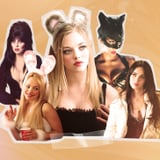As the popular "Mean Girls" quote goes, "Halloween is the one night a year when a girl can dress like a total slut and no other girls can say anything about it." While Cady Heron's words might suggest we should feel judged for dressing sexily on Halloween, according to the history of the holiday, that decision can actually be empowering. Regardless, the sentiment holds true: Halloween undoubtedly gives people the excuse to sex-ify any costume, whether it's the classic black cat or the timely pop culture costume of the year.
The movie depicts the ubiquity of the sexy Halloween costume - you might remember everyone except Cady is dressed as a sexy-something - but it certainly wasn't the first time we saw these provocative costumes represented in the media or in real life.
So when exactly did Halloween become so sexy? The origin of Halloween is traced back to Samhain, a three-day ancient Celtic pagan festival that took place more than 2,000 years ago. Irish immigrants then brought these traditions to the US in the mid-1800s, but it wasn't until the early 1900s when costumes were even a part of the holiday. "Back in the 1900s, people dressed up for everything," explains Lisa Morton, a Halloween and paranormal expert who's authored multiple horror books. "It wasn't something that was exclusive to Halloween, but on Halloween, people were dressing up in more macabre costumes."
And to be clear, these costumes definitely weren't sexy. "I've found descriptions of early ghost and devil costumes, which at that point were just a black leotard," Morton says. "Things were just pulled out of the attic, like Mom's old bandana might turn you into a pirate."
Morton points to an "earth-shattering" shift in costuming in the 1950s, when Halloween retailers Ben Cooper and Collegeville started licensing costumes for existing characters like Superman and Donald Duck. These getups were "much more appealing" to kids and adults alike, after decades of people throwing together simple, homemade costumes.
Image Source: Getty / Carlos Avila Gonzalez
Risqué costumes then came into the picture in the '60s and '70s, amid the gay-liberation and second-wave feminism movements. A rise in queer Halloween parades in major cities, particularly in San Francisco's Castro district and NYC's Greenwich Village, created a safe space for much of the LGBTQ+ community to dress up in over-the-top ensembles. Simultaneously, the second-wave feminism movement made way for a sexual revolution that redefined women's sexuality, which was often expressed through their fashion and beauty choices. While Halloween had previously been primarily for kids, the end of these decades marked the beginning of adults co-opting the holiday.
As Halloween historian and author Lesley Bannatyne explains to POPSUGAR, Halloween costumes typically follow trends in our culture. "They reflect who we are and what we value, what fascinates us or scares us," she says. And that's exactly what occurred in the '70s. These cultural events made way for the normalization of sexy costumes to celebrate the holiday.
Meanwhile, this sexualization in real life was making its way to screens. The late '60s and '70s also introduced the sexual - and often sexist - horror genre. Now-cult-classics like "Psycho," "Night of the Living Dead," and "I Spit on Your Grave" demonstrated how scary films had become irrefutably more violent and erotic than in years past. The onscreen representation only further inspired these types of costumes for adults.
Image Source: Getty / Aaron Rapoport / Corbis
Fast forward to the '80s and '90s, sexy costuming had a "serious explosion" thanks to the popularity of the horror hostess Elvira, according to Morton. After the success of the '80s TV horror program "Elvira's Movie Macabre," actor Cassandra Peterson played her famous character in a Coors commercial to promote the brand's Halloween beer sales. "They didn't have their own major beer holiday before they hired her," Morton explains. "Suddenly, there are standees of her in every grocery store in America, so people were seeing this beautiful, sexy woman associated with Halloween; that had never really been that strong before."
In the 1990s, the expansion of haunted attractions "completed the cycle of transformation" of Halloween into a more adult-focused holiday. "This industry brought its own, sort of R-rated, extreme vibe, which again added to making costuming more out there than it had been in the past," Morton says.
Image Source: Everett Collection
And as Y2K trends and teen movies like "Mean Girls," "Jennifer's Body," and "Legally Blonde" came to the forefront, the Playboy aesthetic, exposed midriffs, schoolgirl uniforms, and more became popular elements of Halloween costumes for women. Revealing costumes continued to get sexier and stayed in vogue the next few decades, until another cultural phenomenon - the #MeToo movement - influenced the trends once again. "Ten years ago, something like 95 percent of costumes for adult women were sexy themed," Morton says. "If you went into a costume store as a woman and you didn't want a sexy costume, you were almost out of luck." However, when the #MeToo movement was reignited in 2017, Morton noticed a shift in costume trends; they stepped away from overt sexiness and returned to the classics.
While sexy costumes are still the norm today, there's plenty more representation of clever, creative costumes; lazy re-creations; and cozier ensembles. All things considered, you should feel empowered to wear whatever costume you like, sexy or not. Whether you're looking to bundle up or bare some skin this Halloween, the options are endless.
